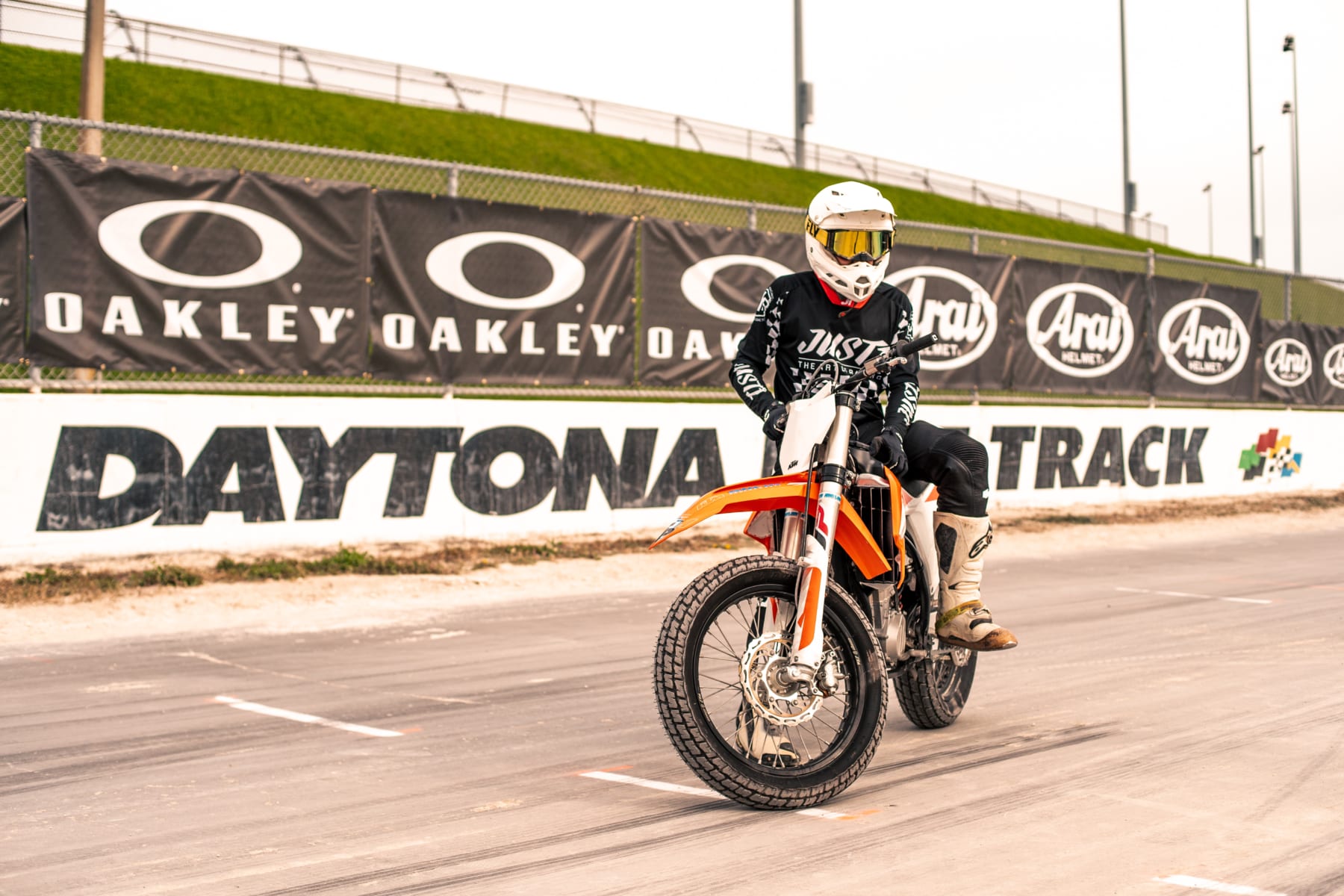Flat track racing is nothing new in America, in fact, the sport is one of our country’s oldest motorsports. However, I’m willing to bet most Americans, even those who are motorcycle enthusiasts, aren’t familiar with the sport.
American Flat Track (AFT) invited me and a few other journalists out to experience AFT for ourselves. We took a tour of Daytona then had time on a practice track with instruction from Jonny Lewis. The season opener will take place at Daytona on March 14th.
The Scene
The thing that first hit me about Daytona was the enormity of it all. Up in the grandstands of Daytona, you look out and see that everything the light touches is the speedway; it’s all about racing there. Nothing else matters.

Daytona’s flat track is the exit portion of the pit lane, the “infield” and a few hundred yards of the track along the front straight. The flat track at Daytona is a ½ mile track and additionally is one of six races in the series to include a jump.
Several major changes were made for the 2020 AFT season. First and foremost is the formal induction of the Super Twin class. While Production Twins existed last year, they only participated in 11 of the 18 races. Production Twins will serve as a stepping stone from Singles to the premier Super Twins class.
Briar Bauman the reigning champ of the Twins class, now Super Twins for 2020, stressed that the highlight flat track racing was the accessibility of the sport. Bauman says he has not only seen a privateer show up with a showroom fresh bike but that the rider also won. While Bauman says that the suspension isn’t set up how he likes it, it just goes to show that you don’t need to go to extremes to get into the sport.

The next major change for the series has been the switch to the new Dunlop DT4, the first advance in a spec tire in the last 40 years. In addition to the hybrid R9 compound, the DT4 is meant to be run tubeless. The AFT series hopes to run only tubeless tires by 2021.
This will affect how riders adjust their tire pressures and should make racing on tracks like Daytona, mixed dirt and asphalt tracks, especially exciting.
The Ride
On the short track, we were met by AFT Super Twin racer Johnny Lewis and a trio of Kawasaki Kx140s. Lewis, in addition to racing himself, runs Moto Anatomy, a flat track academy.
The first lesson Lewis gave us was that this riding flat track is completely different from anything else we have done in. Turning a bike on a flat track circuit basically requires the opposite of turning on the street. The first five or so laps were strictly about reprogramming our brains.

Photo courtesy of AFT
The “moon dust” covering the practice oval made the entire thing incredibly slick. The little Kawasakis were perfect for navigating the oval. They’re lightweight and lack of power made them forgiving, and in turn, made us confident. In Lewis’s words, “You can get away with murder on these.”
A good thing considering that flat track riding did not come naturally to anyone in the group. The street riders had the wrong body position, while the dirt guys had to focus on looking through the turn and foot placement.
Sessions consisted of roughly three to five laps before coming in to get a little coaching from Lewis. Wobbling around a track in first or second gear may not sound like fun, but it honestly is. The two hours of flat track school we had were, without a doubt, some of the most fun I have ever had on a motorcycle.
Hell, some of the most fun I’ve ever had.

Photo courtesy of AFT
Following our time on the KLX 140s, we went out for three laps on Moto Anatomy’s KTM 450. The bump in power made the skill needed by Bauman and his competitors only more apparent.
The Lesson
Although the technical aspects of riding flat track don’t translate to my VFR perfectly, the lessons I learned improved my riding immensely. The biggest thing I learned from my experience was the need to be smooth. Smooth on the throttle, smooth on the brake, smooth on turn-in.
The managing of inputs on the bike can make a crucial difference whether you are on the street or the track. More importantly, this experience has only gotten me more excited to ride. I have been trolling the internet for a dirt bike or super-moto to turn into a flat tracker.
As an advocate for motorcycling as a whole, this is what resonates with me the most. The sport is easily accessible, I recently watched a bunch of sportbikes run a flat track race, and it is insanely fun. I have been trolling the internet for a dirt bike or super-moto to run as a flat tracker.
The second I find one suitable I’ll be out at Perris Auto Speedway near Riverside, CA running laps day and night. Anyone and everyone is more than welcome to watch, or better yet, join me on the track.
[Disclaimer: American Flat Track covered travel, food, and lodging for this story.]


Leave a Reply